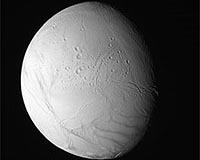|
|
|
Taking The Plunge: Cassini Soars By Enceladus Pasadena CA (SPX) Nov 02, 2009  After so many close flybys of Enceladus, we're starting to feel as if this little moon of Saturn is an old friend. But during the encounter planned for Nov. 2, 2009, we are going to get up-close and personal. Cassini is going to take its deepest dive yet into the plumes spewing out from the moon's south pole to try to learn more about their composition and density. The spacecraft is going ... read more
After so many close flybys of Enceladus, we're starting to feel as if this little moon of Saturn is an old friend. But during the encounter planned for Nov. 2, 2009, we are going to get up-close and personal. Cassini is going to take its deepest dive yet into the plumes spewing out from the moon's south pole to try to learn more about their composition and density. The spacecraft is going ... read moreRosetta's Third Earth Swingby  Paris, France (ESA) Nov 02, 2009
Paris, France (ESA) Nov 02, 2009On 13 November 2009 Rosetta will swing by Earth and pass within 2500 km of Earth's surface. The manoeuvre is the fourth and last in a series of gravity assists and will provide the spacecraft with the required orbital boost to set course for the mission's final destination: comet 67P/Churyumov-Gerasimenko. Since its launch on 2 March 2004 Rosetta has made a long journey through the inner ... more
|
Vietnam says parched Red River at record low
China to be world's third biggest wind power producer: media Cost-cutting NASA eyes three cheap space missions Honduras declares state of emergency amid drought Russia in secret plan to save Earth from asteroid: official Sarkozy scrambles to salvage carbon tax French carbon tax ruled illegal Brazil's Lula signs law cutting CO2 emissions 2009 a 'benign' year of natural disasters: German re-insurer Greenpeace Spain demands Denmark release its director
| |||||||||||||||
| Previous Issues | Oct 30 | Oct 29 | Oct 28 | Oct 27 | Oct 26 |
| . |
Exoplanet House Of Horrors Washington DC (SPX) Nov 02, 2009
Washington DC (SPX) Nov 02, 2009Astronomers may be closer than ever to discovering a planet that's habitable like our own, but along the way they've discovered some very scary exoplanets - places where conditions are far too harsh for life as we know it to exist. We've rounded up some of the most frightening, deadly exoplanets, places that make even the scariest haunted house on Earth pale in comparison. ... more Masten Space Systems Qualifies For One Million Dollar Prize  Mojave CA (SPX) Nov 02, 2009
Mojave CA (SPX) Nov 02, 2009Masten Space Systems successfully qualified for first place in Level Two of the Northrop Grumman Lunar Lander Challenge Wednesday. Flying a brand new vehicle named XA-0.1E (nicknamed Xoie), Masten demonstrated their ability to build, debug and fly a vehicle on a very short timeline. "To come from not flying at all last year to qualifying for level one AND level two of the LLC this year ... more Mega-star explosion most distant object ever seen  Paris (AFP) Oct 29, 2009
Paris (AFP) Oct 29, 2009It took 13 billion years to reach Earth, but astronomers have seen the light of an exploding mega-star that is the most distant object ever detected, two studies published Thursday reported. The stunning gamma-ray burst (GRB) was observed by two teams of researchers in April, and opens a window onto a poorly known period when the Universe was in its infancy. GRBs are the most violent ... more |
. |
| . |
Blast From The Past Gives Clues About Early Universe Charlottesville VA (SPX) Oct 29, 2009
Charlottesville VA (SPX) Oct 29, 2009Astronomers using the National Science Foundation's Very Large Array (VLA) radio telescope have gained tantalizing insights into the nature of the most distant object ever observed in the Universe - a gigantic stellar explosion known as a Gamma Ray Burst (GRB). The explosion was detected on April 23 by NASA's Swift satellite, and scientists soon realized that it was more than 13 billion ... more World's Fastest Supercomputer Models Origins Of The Unseen Universe  Los Alamos NM (SPX) Oct 28, 2009
Los Alamos NM (SPX) Oct 28, 2009Understanding dark energy is the number one issue in explaining the universe, according to Salman Habib, of the Laboratory's Nuclear and Particle Physics, Astrophysics and Cosmology group. "Because the universe is expanding and at the same time accelerating, either there is a huge gap in our understanding of physics, or there is a strange new form of matter that dominates the universe ... more The Sun's Sneaky Variability  Huntsville AL (SPX) Oct 28, 2009
Huntsville AL (SPX) Oct 28, 2009Every 11 years, the sun undergoes a furious upheaval. Dark sunspots burst forth from beneath the sun's surface. Explosions as powerful as a billion atomic bombs spark intense flares of high-energy radiation. Clouds of gas big enough to swallow planets break away from the sun and billow into space. It's a flamboyant display of stellar power. So why can't we see any of it? Almost none ... more |
. |
| Previous Issues | Oct 30 | Oct 29 | Oct 28 | Oct 27 | Oct 26 |
| The contents herein, unless otherwise known to be public domain, are Copyright 1995-2009 - SpaceDaily. AFP and UPI Wire Stories are copyright Agence France-Presse and United Press International. ESA Portal Reports are copyright European Space Agency. All NASA sourced material is public domain. Additional copyrights may apply in whole or part to other bona fide parties. Advertising does not imply endorsement, agreement or approval of any opinions, statements or information provided by SpaceDaily on any web page published or hosted by SpaceDaily. Privacy statement |